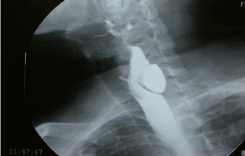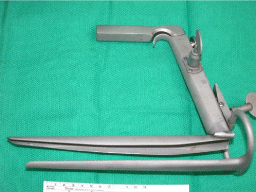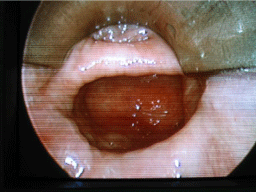Review Article
Zenker’s Diverticulum: Endoscopic Surgical Management Options
Frank R Miller* and Christine Taylor
Department of Otolaryngology-Head and Neck Surgery, University of Texas Health Science Center San Antonio, USA
*Corresponding author: Frank R Miller, Department of Otolaryngology-Head and Neck Surgery, University of Texas Health Science Center San Antonio, San Antonio, TX 78229, USA
Published: 24 Apr, 2017
Cite this article as: Miller FR, Taylor C. Zenker’s
Diverticulum: Endoscopic Surgical
Management Options. Clin Surg. 2017;
2: 1422.
Abstract
Zenker diverticulum (ZD) is an uncommon pharyngo-esophageal outpouching that occurs in an area of muscular weakness at the junction of the inferior aspect of the inferior constrictor muscle and the cricophayngeus muscle (Killian dehiscence). As the diverticlulum enlarges it produces progressive dysphagia, regurgitation, and aspiration. The classic approach has been to do an open diverticulectomy in conjunction with a cricopharyngeal myotomy. While successful, the open approach is associated with significant cost, extended recovery time, and surgical morbidity. More recently the minimally invasive endoscopic diverticulostomy has been advocated as the procedure of choice to manage the majority of patients with ZD. This endoscopic technique consists of a trans-oral surgical procedure that divides the septum (party wall) between the ZD and the cervical esophagus. This mini-review will provide an overview of the current status of the use of the minimally invasive endoscopic technique with particular emphasis on the efficacy of the surgical procedure, safety of the procedure compared to open surgical techniques, and the cost savings associated with the minimally invasive technique.
Introduction
Zenker diverticulum (ZD) is a pharyngo-esophageal diverticulum/outpouching that is
typically seen in older patients. Anatomically it is a diverticulum that forms between the inferior
constrictor muscle and the cricopharyngeus muscle (upper esophageal sphincter). This area of
junctional weakness is known as Killian’s triangle and represents an inherently weak region of the
pharyngo-esophageal segment [1-8]. It is most commonly diagnosed with a barium swallow study
(Figure 1). Symptoms may range from mild globus pharyngeus and dysphagia to severe dysphagia,
regurgitation, and aspiration. In severe cases patients may have recurrent pneumonia/bronchitis
and have to rely on gastrostomy tube feedings for nutrition. In addition to the inability to safely
swallow it can negatively impact quality of life and deprive the patient of the ability to eat by mouth
[1-3,8-15].
The pathophysiology of ZD remains unclear but is felt to be secondary to repeated dysfunction
between the upper esophageal sphincter (UES) relaxation and pharyngeal contraction during
swallowing. This dyscoordination results in a failure of appropriate relaxation of the UES and
abnormally high intra-esophageal pressures that lead to the formation of a pseudo-diverticulum [2].
For many years the traditional treatment of ZD consisted of an open surgical approach that
typically included a diverticulectomy combined with crico-pharyngeal myotomy. This open surgical
approach was very successful but came with some morbidity (and even mortality) particularly in
the typical elderly patient. Among the potential complications were recurrent laryngeal nerve
injury, pharyngo-cutaneous fistula, and mediastinitis. Mortality rates as high as 2% to 4% have been
reported with the open surgical approach [1,2].
Over the past 15+ years there has been a trend toward minimally invasive surgery across a wide
variety of surgical procedures. The goal of minimally invasive surgery is to reduce operative time,
lower the complications associated with open surgical procedures, and expedite hospital discharge
thus reducing overall health care costs [1-24]. This approach has been extended to the management
of ZD with a large experience accumulated in the use of endoscopic diverticulostomy to open the
diverticulum into the cervical esophagus. In many institutions the minimally invasive approach
has emerged as the surgical technique of choice to manage ZD [1,4,6,12]. Several classification
systems for Zenker’s diverticulum have been proposed including the Brombart and the Morton
Bartley systems. The Morton/Bartley system classifies the diverticulum based on size with Stage I (< 2 cm), Stage II (2-4 cm), and Stage III (>4 cm). Our experience
has been that, while helpful, the true assessment of suitability
for endoscopic diverticulostomy is best assessed with an exam
under anesthesia and an attempt at endoscopic exposure. The key
component of the endoscopic approach is the ability to expose the
party wall (Cricopharyngeus region) and transect that to the base of
the diverticular sac. Even small diverticulum < 2 cm (Stage I) may
be amenable to endoscopic diverticulostomy or endoscopic cricopharyngeal
myotomy. In the event that the small diverticulum cannot
be managed endoscopically we then consider an open approach for a
crico-pharyngeal myotomy. The purpose of this paper is to review the
current state of the art of the minimally invasive surgical techniques
in the management of ZD.
Current Minimally Invasive Surgical Options
Transoral rigid endoscopy
Over the last 15 years there has been a large experience developed
utilizing a minimally invasive technique in the management of
ZD. The procedure consists of using a bi-valve diverticuloscope
(Weerda bivalve; Karl Storz, Culver City, CA; (Figure 2) to expose the
diverticulum and the party wall between the diverticular sac and the
esophageal lumen (Figure 3) [1-20]. The concept is to then transect the
party wall between the ZD and the esophagus thus creating an open
diverticulostomy. The open diverticulostomy is thus prevented from
collecting food/debris and often results in significant improvement or
resolution of the dysphagia, regurgitation, and aspiration. A variety
of tools have been utilized to transect the party wall including the
CO2 laser, the endoscopic linear stapler/cutting device, and more
recently the harmonic scalpel. Some reports suggest the endoscopic
technique is safer with lower risk of perforation, fistula, and mediastinitis due to the fact that the stapler technique closes off the
cut edges [1,2,6,12,14]. The operative technique is done under direct
endoscopic visualization with a 0 degree telescope. Numerous papers
have been published with all three techniques (CO2 laser, stapler, and
harmonic scalpel) demonstrating excellent results. At this point there
has been no controlled study that compares the various party wall
cutting tools. The endoscopic stapling device is the most commonly
utilized minimally invasive technique and has consistently shown
excellent outcome in greater than 90% of surgical cases. Success is
generally accessed via swallowing symptom control via surveys
that assess resolution of dysphagia, resumption full diet and lack
of regurgitation. In England the endoscopic stapling technique is
endorsed by the National Institute for Clinical Excellence (NICE).
In a review of 585 patients 92.3% underwent endoscopic trans-oral
stapling with a success rate of >90%. The overall recurrence rate was
12.8% of which many can undergo a second attempt at endoscopic
stapling. Most importantly the endoscopic stapling technique appears
to be safe and well tolerated. It has low morbidity, rapid recovery time
(typically resume oral intake within 12 to 24 hours), discharge home
within 24 hours and low risk of fistula and nerve injury [17].
As noted above the major advantage of the minimally invasive
endoscopic technique is the low incidence of major complications. The
traditional open surgical approach including diverticulectomy has a
higher rate of major complications in 15% to 30% of cases including
fistula (6%), recurrent laryngeal nerve injury (4%), mediastinitis (2-
3%), and mortality rate of 2%. The overall risk of major complications
in endoscopic technique for ZD is in the range of 1%-2% with rare
cases of fistula, nerve injury, and mediastinitis [1,4,6,12-16]. Most
complications of endoscopic technique are related to inability to
expose the diverticular sac and dental injuries [1].
From a quality of life standpoint a number of studies have
demonstrated significant improvements in various swallowing
parameters. Miller “et al.” [1] demonstrated a significant improvement
in both dysphagia and regurgitation scores after endoscopic
diverticulostomy utilizing both the CO2 laser and the endoscopic
stapler. Overall 86% of the patients demonstrated good oral intake
with 24 h and there were no major complications. In a more recent
study Bonavina “et al.” [19] analyzed 100 patients who underwent
trans-oral endoscopic stapling of the ZD. A statistically significant
improvement in dysphagia and regurgitation scores (p< 0.001) was
noted with a median follow-up of over 5 years. In a similar fashion
there was a significant decrease in the episodes of pneumonia and
the overall success rate was 76%. Most importantly the procedure is well tolerated and had minimal complications. This study had one of
the longer follow-up periods providing evidence that the swallowing
improvements are sustainable over time. Another advantage of the
endoscopic technique is that it does not limit the surgeon’s ability
to perform revision endoscopic diverticulostomy in patients who
have failed previous endoscopic or open ZD repair. Scher reported a
series of 18 patients with recurrent ZD (9 previous endoscopic repair
and 9 by open external approach). Despite the previous surgery 16
of the 18 patients (89%) had partial or complete relief of symptoms
after endoscopic stapling diverticulostomy with follow-up ranging
from 9 to 60 months [10]. In our practice we offer all patients and
opportunity for endoscopic ZD repair including patients who have
had prior surgical intervention.
In addition to its efficacy in improving the swallowing dysfunction
associated with ZD, the endoscopic approach has been associated
with shortened hospital stay and significant cost savings. Smith “et
al.” [15] did a retrospective analysis of 16 patients that underwent
surgical management of the ZD (8: Endoscopic diverticulostomy
versus 8: standard open diverticulectomy) [15]. They found that
compared to the standard open technique, the endoscopic stapling
technique demonstrated a shorter operative time, a shorter hospital
stay, and a shorter time to resumption of oral intake. The overall total
hospital charges were significantly less for the group that underwent
endoscopic minimally invasive surgery with the average total
hospital charges reduced by approximately 65%. In this era of cost
containment these savings are not insignificant.
Rare reports of carcinoma or carcinoma in situ arising from
the lining of a ZD have been reported [20]. Overall the risk of
carcinoma arising from the ZD has been reported to be less than 1%.
It is recommended that the surgeon perform a careful endoscopic
examination of the diverticulum prior to any intervention. Any
mucosal abnormalities can be biopsied to rule out malignancy. In
the rare event a malignancy is identified the surgeon should consider
an open traditional diverticulectomy to fully excise the diverticular
sac and possible ipsilateral para-tracheal node dissection Adjuvant
radiation therapy may be recommended depending on the final
pathology.
One of the challenges with the endoscopic minimally invasive
technique is that is requires the patient to be put under a general
anesthesia. Many of the ZD patients are elderly and have significant
co-morbidities thus obtaining anesthesia clearance can be a challenge.
This has resulted in an interest in developing techniques with flexible
endoscopy that would allow the surgeon to do these procedures under
sedation (avoid general anesthesia). The next section will review the
state of flexible endoscopy.
Flexible endoscopy
The role of flexible endoscopy is less established in the
management of ZD. The concept of utilizing flexible endoscopy
arose from the need to try to develop a technique that is minimally
invasive yet does not require a general anesthesia [21-23]. There has
been an interest by interventional gastroenterologists to develop a
technique and the appropriate tools that would allow the endoscopist
to perform a diverticulostomy with the patient under sedation. The
purported advantage is the avoidance of a general anesthesia in the
elderly frail patient. In addition the flexible endoscopic technique
could be utilized in patients with anatomy that precludes the use of
the traditional rigid endoscopy.
The flexible technique is performed utilizing a standard flexible
endoscope and a variety of devices (needle knife, argon plasma
coagulation, forceps coagulation, etc.) are utilized to cut the party
wall between the diverticulum and the esophagus. The instrument
is typically selected by the endoscopist based on training and
experience and no studies have compared the instruments regarding
safety and efficacy. In a recent review article, Perbtani “et al.” [21]
reviewed 19 published case series of flexible endoscopy to manage
ZD in 670 patients. The majority of these studies were case series
with limited objective assessment of swallowing improvement [21].
In addition it appears to be more common that patients may need
a subsequent second or third procedure to adequately complete the
transection of the diverticular wall. In a case series from the Mayo
Clinic 22 consecutive patients were treated using flexible endoscopic
techniques [22]. The diverticular wall was transected with a needle
knife and electrocautery. Eight of the patients (36%) were hospitalized
after the procedure with a mean length of hospitalization of 2.9 days.
Perforation was reported in 6 patients (27%). Fourteen of the patients
(64%) had no complications. Many of the patients were deemed
unsuitable for standard rigid endoscopic management with general
anesthesia due to advanced age and serious medical co-morbidities.
Overall 15 of the 22 patients (68%) reported complete/near
complete symptoms resolution (dysphagia, regurgitation, recurrent
pneumonia). The flexible endoscopic technique may be an option in
patients who are not candidates for a rigid endoscopic approach. As
the technology and experience evolves we may see better equipment
that will improve the ability to use flexible endoscopy to manage ZD.
In our current practice we utilize rigid endoscopic diverticulostomy
in the management of the majority of patients with symptomatic ZD.
At this point in time the use of flexible endoscopy is limited in its
application.
Figure 1
Figure 2
Figure 3
Figure 3
Endoscopic exposure of Zenker diverticulum sac and party wall
between the diverticular sac and the cervical esophagus.
Conclusion
The use of the minimally invasive rigid endoscopic diverticulostomy to manage patients with ZD is now a proven surgical technique. Over the last 15 years this endoscopic technique has been utilized in hundreds of patients with great success. In our opinion it has replaced the traditional open approach with diverticulectomy as the first line surgical treatment of ZD. The endoscopic approach is safe and effective in over 90% of patients and does not eliminate other treatment options. In addition the endoscopic approach has been demonstrated to lead to shorter operative time, shorter hospital stay, and quicker resumption of oral intake. These factors contribute to a 65% reduction in overall hospital charges when compared to the traditional open surgical approach with diverticulectomy. Quality of life scores as reflected in swallowing improved in 90% of patients.
References
- Miller FR, Bartley J, Otto RA. The endoscopic management of Zenker diverticulum: CO2 laser versus endoscopic stapling. Laryngoscope. 2006;116:1608-11.
- Prisman E, Genden EM. Zenker diverticulum. Otolaryngol Clin North Am. 2013;46(6):1101-11.
- Repici A, Pagano N, Fumagalli U, Peracchia A, Narne S, Malesci A, et al. Transoral treatment of Zenker diverticulum: flexible endoscopy versus endoscopic stapling. A retrospective comparison of outcomes. Dis Esophagus. 2011;24:235-9.
- Bock JM, Van Daele DJ, Gupta N, Blumin JH. Management of Zenker's diverticulum in the endoscopic age: current practice patterns. Ann Otol Rhinol Laryngol. 2011;120(12):796-806.
- Peracchia A, Bonavina L, Narne S, Segalin A, Antoniazzi L, Marotta G. Minimally invasive surgery for Zenker diverticulum: analysis of results in 95 consecutive patients. Arch Surg. 1998;133(7):695-700.
- Cook RD, Huang PC, Richstemeier WJ, Scher RL. Endoscopic staple assisted esophagodiverticulostomy: An excellent treatment of choice for Zenker’s diverticulum. Laryngoscope. 2000;110:2020-5.
- Von Doersten PG, Byl FM. Endoscopic Zenker’s diverticulostomy (Dohlman procedure): Forty cases reviewed. Otolaryngol Head Neck Surg. 1997;116:209-12.
- Thaler ER, Weber RS, Goldberg AN, Weinstein GS, Raut VV, Primrose WJ. Feasibility and outcome of endoscopic staple Long term results of endoscopic stapling diverticulostomy. 2001;111:1506-08.
- Veenker E, Cohen JI. Current trends in management of Zenker diverticulum. Curr Opin Otolaryngol Head Neck Surg. 2003;11(3):160-5.
- Scher RL. Endoscopic staple diverticulostomy for recurrent Zenker's diverticulum. Laryngoscope. 2003;113(1):63-7.
- De Casso C, Lalam M, Ghosh S, Timms M. Endoscopic stapling diverticulotomy: an audit of difficulties, outcome, and patient satisfaction. Otolaryngol Head Neck Surg. 2006;134:288-93.
- Philippsen LP, Weisberger EC, Whiteman TS, Schmidt JL. Endoscopic stapled diverticulotomy: treatment of choice for Zenker's diverticulum. Laryngoscope. 2000;110(8):1283-6.
- Raut VV, Primrose WJ. Long-term results of endoscopic stapling diverticulotomy for pharyngeal pouches. Otolaryngol Head Neck Surg. 2002;127(3):225-9.
- Chang CWD, Burkey BB, Netterville JL, Courey MS, Garrett CG, Bayles SW. Carbon dioxide laser endoscopic diverticulotomy versus open diverticulectomy for Zenker’s diverticulum. Laryngoscope. 2004;114:519-27.
- Smith SR, Genden EM, Urken ML. Endoscopic stapling technique for the treatment of Zenker diverticulum vs standard open-neck technique: a direct comparison and charge analysis. Arch Otolaryngol Head Neck Surg. 2002;128(2):141-4.
- Whited C, Lee WT, Scher R. Evaluation of endoscopic harmonic diverticulostomy. Laryngoscope. 2012;122(6):1297-300.
- Leong SC, Wilkie MD, Webb CJ. Impact of endoscopic stapling of Zenker's diverticulum on patient health status as assessed by the Glasgow Benefit Inventory. Ann Otol Rhinol Laryngol. 2012;121(9):576-8.
- Palmer AD, Herrington HC, Rad IC, Cohen JI. Dysphagia after endoscopic repair of Zenker's diverticulum. Laryngoscope. 2007;117(4):617-22.
- Bonavina L, Aiolfi A, Scolari F, Bona D, Lovece A, Asti E. Long-term outcome and quality of life after transoral stapling for Zenker diverticulum. World J Gastroenterol. 2015;21(4):1167-72.
- Acharya A, Jennings S, Douglas S, Mirza S, Beasley N. Carcinoma arising in pharyngeal pouch previously treated by endoscopic stapling. Laryngoscope. 2006;116:1043-5.
- Perbtani Y, Suarez A, Wagh MS. Techniques and efficacy of flexible endoscopic therapy of Zenker's diverticulum. World J Gastrointest Endosc. 2015;7(3):206-12.
- Case DJ, Baron TH. Flexible endoscopic management of Zenker diverticulum: the Mayo Clinic experience. Mayo Clin Proc. 2010;85(8):719-22.
- Dzeletovic I, Ekbom DC, Baron TH. Flexible endoscopic and surgical management of Zenker's diverticulum. Expert Rev Gastroenterol Hepatol. 2012;6(4):449-65.
- van Overbeek JJ. Pathogenesis and methods of treatment of Zenker's diverticulum. Ann Otol Rhinol Laryngol. 2003;112(7):583-93.



